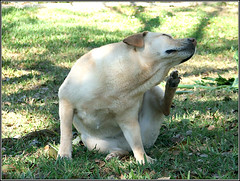When people see their dog scratching a lot, they automatically assume it has fleas. Although flea bites do cause itching, the truth is that dogs can be allergic to certain food products, environmental pollutants, bug bites, dust mites, pollen and exposure to the sun. Dogs can be allergic to, among other things, another animal and even to their very own owners. These all cause dogs to have itchy skin.
Dogs that are observed scratching more than usual should have their skins checked carefully. If the skin is red and scaly or scabby, or the owner notices unusual hair loss, the dog should be taken to the vet. Sometimes, a dog’s paws will become swollen from constant licking and chewing. All these signs are symptoms of allergies.
Diagnosing dog allergies that cause itching.
Dogs can be allergic to the same substances that cause human allergies. In order to identify the specific allergen, the veterinarian performs the same types of tests that allergists perform on humans. Dogs may need to be put on an elimination diet to determine if they are allergic to a certain food. Skin and blood tests may be performed. If the problem cannot be diagnosed, or treatment seems ineffective, the dog should be seen by a veterinary dermatologist.
Natural Remedies.
Some of the same remedies to relieve the allergic itching that are prescribed for humans are also prescribed for dogs. This includes antihistamines and steroids. There are also a number of natural remedies that can be tried.
• The dog should be bathed weekly with a soothing shampoo recommended by a vet.
• Feed the dog only hypoallergenic food.
• Grind oatmeal into a powder and rub into the coat. It relieves itching, but may need to be applied several times a day.
• Rub baking soda into the coat and skin to relieve itching.
• Avoid using chemicals on your pet. Flea collars should be avoided, since they contain toxic chemicals causing allergic reactions in many dogs.
• Dogs that have allergies to the sun need to have sunscreen applied before going outside.
• Adding some herbs and fatty acids to the diet, with the approval of your vet, may alleviate the itching.
• There are chewable dog allergy tablets with herbs and special herbal shampoos that can be purchased through your vet or online that are designed specifically to treat a dog’s itchy skin.








